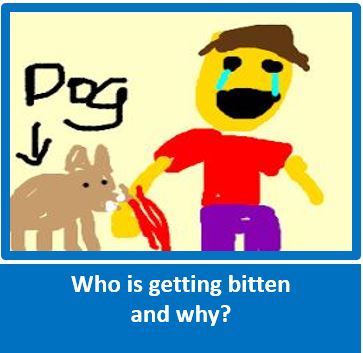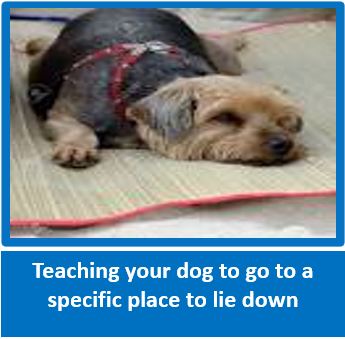
Please visit and LIKE our Facebook Page and share with family, friends and on your own Facebook page, and ask them to share further – it is only by working together and sharing knowledge and education that we can improve the lives of dogs and assist owners. We do not inundate you with posts – an average of 5 per week, and the odd Did You Know. Thank You!
DOG FIGHTS AT HOME
By Karen Gray-Kilfoil (Cape)
Karen has a B.A. degree in Social Sciences and Humanities, with special emphasis on social, developmental and educational psychology, including one year of biology. She has an Advanced Certificate in Companion Animal Behaviour and a Certificate in Animal Assisted Activities from the Ethology Academy, Pretoria

Dog fights are one of the most terrifying events to witness. Not only can the dogs injure or even kill each other, but often people get badly bitten trying to separate them.
When two dogs in the same household start fighting regularly it is stressful for both owners and dogs, which perpetuates the problem as stress is often an underlying cause to begin with.
What causes dogs in the same home to fight? Some common causes:
Breeds:
Certain breeds are more likely to fight, even if they’re family members of opposite sexes. All terriers, especially Staffordshire and Pit Bull Terriers, fit into this category. If you can help it don’t own two of these dogs together.
Hormones:
Too much testosterone (entire males) can cause aggression to flare more easily in an attempt to be macho. Owning two entire males should be avoided. Rather castrate the youngest, smallest, less assertive one. A bitch in season (on heat), in whelp (pregnant) or with pups may be more unpredictable and aggressive. A bitch in season may cause other more senior dogs to be aggressive towards her as she represents a threat to their status in the "pack". Spaying bitches before the first heat is a good idea.
Disciplining puppies:
Older dogs often show younger ones who’s boss by growling, biting (usually gently) or pinning them to the ground. Although this is quite normal and should be ignored, often owners are afraid that their pup will be hurt and intervene, making things worse. Keep out of these kinds of squabbles as much as possible, within reason. The older dog should never be reprimanded or punished.
Juvenile delinquent dogs: Young dogs between the ages of six and 18 months are most likely to challenge other dogs in the household, especially (I have found) if they are terriers or large guard dog breeds (like Boerboels and Rottweilers). Usually this is related to possessiveness and attention-seeking. This is a phase which is often difficult to deal with, but often doesn’t result in any blood lost if handled correctly. Neutering, modifying the relationships between owners and dogs and using correct calming body language helps to widen the gaps between fights.
Elderly and sickly dogs:
Often elderly or sickly dogs are picked on by younger dogs. This is probably due to the law of the jungle and there isn’t much that can be done, other than treating the sickly dog or separating them permanently.
Possessiveness:
Food, toys or attention may be a trigger for a dog fight, but there’s always an underlying cause, such as high stress levels and over-attachment to an owner. The underlying causes need to be addressed. At the same time dogs can be fed separately, not given toys except when separated, and given attention separately and calmly.
Excitement and frustration: Often dogs attack each other when another dog is passing the gate, when play gets too rough or when visitors arrive.
High stress levels:
Dogs respond to stressful situations just as much as people and often they reflect their owners’ stress. Moving house, having a baby, introducing a new pet or person into the household, renovating the house, death and illness often affect pets’ behaviour and health. Anxiety is often increased when one or both dogs become over-attached to one person. A dog can be insecure of his own status if his owner is too indulgent and allows the dog to manipulate him too much. Relieving stress can involve more regular walks, correct touch, toys, calm play and positive reinforcement training.
Usually there is a combination of possible causes so all solutions should be considered together.
Re-introducing dogs:
Once the dogs have been separated for any length of time it is quite tricky re-introducing them and you may need an animal behaviourist to help. This should be done on neutral territory (like a park) on long loose leads, possibly using head harnesses. Correct body language must be implemented by the owners and any aggression should not be punished or reprimanded at all. Sometimes it is necessary to re-introduce them over a few days or weeks, while alternating the areas where they are kept at home (to prevent territorial aggression).
Separating dog fights:
Obviously it’s better to prevent fights before they start. If there’s any tension between the dogs try walking away from the scene and distracting one dog by calling in a high-pitched happy voice or using some other noise, toy or food. Don’t stare at the dogs, scream or wait for something to happen – move smoothly away from the dogs.
If there is a fight and you feel you need to intervene remember that your dogs may think you are joining in and increase the pace of the fight. Sometimes a handy water pistol or even mace may be useful, but these sometimes make the dogs even more aggressive. The most effective ways of separating a fight are:
Get as far away as possible from the dogs and wait for the fight to end. This is the most sensible, as you are not going to get bitten. With the exception of fighting breeds this usually has the effect of shortening the duration of the fight, especially if you distract one with an attractive noise, like banging a food bowl.
If there are two of you, you could try each pulling one dog’s back legs. Be careful of the sharp end (teeth!) as it may be turned on you. You may also damage your dogs’ legs.
Spray the dogs with the hose. This is good because it is harmless to the dogs and you don’t have to get too close.
Throwing them into the swimming pool is another favourite, but requires some skill and strength. However this may be the only way to separate a serious fight, as they have to release the bite to breathe.
Stick your finger up your dog’s anus. This is too disgusting for most people to even consider, but it apparently works!
Owners must remember that dogs can and have killed other dogs, so consider the risks before embarking on a behaviour modification program. Sometimes it’s kinder and safer to re-home one dog, or keep them permanently separated. Not all conflicts can be solved in the same way.
(from FOTD - one of the ways we find very effective it to throw something over the dogs heads - each dog if possible - while the dog is 'blinded' quickly separate the dogs keeping the item over the head until they are apart. Be careful when taking the item off the dog as re-directed aggression can occur if the stress levels are too high)
When two dogs in the same household start fighting regularly it is stressful for both owners and dogs, which perpetuates the problem as stress is often an underlying cause to begin with.
What causes dogs in the same home to fight? Some common causes:
Breeds:
Certain breeds are more likely to fight, even if they’re family members of opposite sexes. All terriers, especially Staffordshire and Pit Bull Terriers, fit into this category. If you can help it don’t own two of these dogs together.
Hormones:
Too much testosterone (entire males) can cause aggression to flare more easily in an attempt to be macho. Owning two entire males should be avoided. Rather castrate the youngest, smallest, less assertive one. A bitch in season (on heat), in whelp (pregnant) or with pups may be more unpredictable and aggressive. A bitch in season may cause other more senior dogs to be aggressive towards her as she represents a threat to their status in the "pack". Spaying bitches before the first heat is a good idea.
Disciplining puppies:
Older dogs often show younger ones who’s boss by growling, biting (usually gently) or pinning them to the ground. Although this is quite normal and should be ignored, often owners are afraid that their pup will be hurt and intervene, making things worse. Keep out of these kinds of squabbles as much as possible, within reason. The older dog should never be reprimanded or punished.
Juvenile delinquent dogs: Young dogs between the ages of six and 18 months are most likely to challenge other dogs in the household, especially (I have found) if they are terriers or large guard dog breeds (like Boerboels and Rottweilers). Usually this is related to possessiveness and attention-seeking. This is a phase which is often difficult to deal with, but often doesn’t result in any blood lost if handled correctly. Neutering, modifying the relationships between owners and dogs and using correct calming body language helps to widen the gaps between fights.
Elderly and sickly dogs:
Often elderly or sickly dogs are picked on by younger dogs. This is probably due to the law of the jungle and there isn’t much that can be done, other than treating the sickly dog or separating them permanently.
Possessiveness:
Food, toys or attention may be a trigger for a dog fight, but there’s always an underlying cause, such as high stress levels and over-attachment to an owner. The underlying causes need to be addressed. At the same time dogs can be fed separately, not given toys except when separated, and given attention separately and calmly.
Excitement and frustration: Often dogs attack each other when another dog is passing the gate, when play gets too rough or when visitors arrive.
High stress levels:
Dogs respond to stressful situations just as much as people and often they reflect their owners’ stress. Moving house, having a baby, introducing a new pet or person into the household, renovating the house, death and illness often affect pets’ behaviour and health. Anxiety is often increased when one or both dogs become over-attached to one person. A dog can be insecure of his own status if his owner is too indulgent and allows the dog to manipulate him too much. Relieving stress can involve more regular walks, correct touch, toys, calm play and positive reinforcement training.
Usually there is a combination of possible causes so all solutions should be considered together.
Re-introducing dogs:
Once the dogs have been separated for any length of time it is quite tricky re-introducing them and you may need an animal behaviourist to help. This should be done on neutral territory (like a park) on long loose leads, possibly using head harnesses. Correct body language must be implemented by the owners and any aggression should not be punished or reprimanded at all. Sometimes it is necessary to re-introduce them over a few days or weeks, while alternating the areas where they are kept at home (to prevent territorial aggression).
Separating dog fights:
Obviously it’s better to prevent fights before they start. If there’s any tension between the dogs try walking away from the scene and distracting one dog by calling in a high-pitched happy voice or using some other noise, toy or food. Don’t stare at the dogs, scream or wait for something to happen – move smoothly away from the dogs.
If there is a fight and you feel you need to intervene remember that your dogs may think you are joining in and increase the pace of the fight. Sometimes a handy water pistol or even mace may be useful, but these sometimes make the dogs even more aggressive. The most effective ways of separating a fight are:
Get as far away as possible from the dogs and wait for the fight to end. This is the most sensible, as you are not going to get bitten. With the exception of fighting breeds this usually has the effect of shortening the duration of the fight, especially if you distract one with an attractive noise, like banging a food bowl.
If there are two of you, you could try each pulling one dog’s back legs. Be careful of the sharp end (teeth!) as it may be turned on you. You may also damage your dogs’ legs.
Spray the dogs with the hose. This is good because it is harmless to the dogs and you don’t have to get too close.
Throwing them into the swimming pool is another favourite, but requires some skill and strength. However this may be the only way to separate a serious fight, as they have to release the bite to breathe.
Stick your finger up your dog’s anus. This is too disgusting for most people to even consider, but it apparently works!
Owners must remember that dogs can and have killed other dogs, so consider the risks before embarking on a behaviour modification program. Sometimes it’s kinder and safer to re-home one dog, or keep them permanently separated. Not all conflicts can be solved in the same way.
(from FOTD - one of the ways we find very effective it to throw something over the dogs heads - each dog if possible - while the dog is 'blinded' quickly separate the dogs keeping the item over the head until they are apart. Be careful when taking the item off the dog as re-directed aggression can occur if the stress levels are too high)
Readers Comment
I have been breeding Kerry Blue Terriers for 30 or so years. Over this time I have unfortunately experienced fights between the Kerrys. Terriers after all do fight more than other breeds.
I thought I would add a little bit about stopping a dog fight more easily than any of the suggestions in the piece "Dog Fights At Home"
The easiest way to stop a nasty dog fight is to spray the dogs with something that tastes nasty like vinegar or even beer. Vinegar in the eyes happens, but then their eyes can be washed out soon and no damage.
The only other way of stopping a fight that is mentioned that works is into a swimming pool, but never a bull or staffy terrier - they do not swim and can drown if not pulled out quickly. I have seen this happen.
Using a hose only gets two wet dogs. - Margaret O'Carroll
I have been breeding Kerry Blue Terriers for 30 or so years. Over this time I have unfortunately experienced fights between the Kerrys. Terriers after all do fight more than other breeds.
I thought I would add a little bit about stopping a dog fight more easily than any of the suggestions in the piece "Dog Fights At Home"
The easiest way to stop a nasty dog fight is to spray the dogs with something that tastes nasty like vinegar or even beer. Vinegar in the eyes happens, but then their eyes can be washed out soon and no damage.
The only other way of stopping a fight that is mentioned that works is into a swimming pool, but never a bull or staffy terrier - they do not swim and can drown if not pulled out quickly. I have seen this happen.
Using a hose only gets two wet dogs. - Margaret O'Carroll




